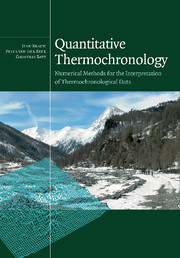Book contents
- Frontmatter
- Contents
- Preface
- 1 Introduction
- 2 Basics of thermochronology: from t–T paths to ages
- 3 Thermochronological systems
- 4 The general heat-transport equation
- 5 Thermal effects of exhumation
- 6 Steady-state two-dimensional heat transport
- 7 General transient solution – the three-dimensional problem
- 8 Inverse methods
- 9 Detrital thermochronology
- 10 Lateral advection of material
- 11 Isostatic response to denudation
- 12 The evolution of passive-margin escarpments
- 13 Thermochronology in active tectonic settings
- Appendix 1 Forward models of fission-track annealing
- Appendix 2 Fortran routines provided with this textbook
- Appendix 3 One-dimensional conductive equilibrium with heat production
- Appendix 4 One-dimensional conductive equilibrium with anomalous conductivity
- Appendix 5 One-dimensional transient conductive heat transport
- Appendix 6 Volume integrals in spherical coordinates
- Appendix 7 The complementary error function
- Appendix 8 Pecube user guide
- Appendix 9 Tutorial solutions
- References
- Index
Appendix 9 - Tutorial solutions
Published online by Cambridge University Press: 15 December 2009
- Frontmatter
- Contents
- Preface
- 1 Introduction
- 2 Basics of thermochronology: from t–T paths to ages
- 3 Thermochronological systems
- 4 The general heat-transport equation
- 5 Thermal effects of exhumation
- 6 Steady-state two-dimensional heat transport
- 7 General transient solution – the three-dimensional problem
- 8 Inverse methods
- 9 Detrital thermochronology
- 10 Lateral advection of material
- 11 Isostatic response to denudation
- 12 The evolution of passive-margin escarpments
- 13 Thermochronology in active tectonic settings
- Appendix 1 Forward models of fission-track annealing
- Appendix 2 Fortran routines provided with this textbook
- Appendix 3 One-dimensional conductive equilibrium with heat production
- Appendix 4 One-dimensional conductive equilibrium with anomalous conductivity
- Appendix 5 One-dimensional transient conductive heat transport
- Appendix 6 Volume integrals in spherical coordinates
- Appendix 7 The complementary error function
- Appendix 8 Pecube user guide
- Appendix 9 Tutorial solutions
- References
- Index
Summary
Tutorial 1
The computed ages are summarized in Table A9.1. The ages obtained with Mad_He are all very close to 40 Myr, demonstrating that inverting an age dataset to obtain a temperature history is a non-unique problem. Many thermal histories can lead to the same age. Note also that Dodson's method is valid only for simple cooling histories. The absolute-closure-temperature method is almost always inaccurate.
Fission-track-length distributions as computed from MadTrax.f are shown in Figure A9.1. Rapid cooling (scenario 1) leads to a narrow track distribution whereas slow cooling (scenario 2) leads to a broad track distribution.
Tutorial 2
Muscovite 40Ar/39 Ar ages are 40 Myr for the first scenario, and > 100 Myr for the four others. Except for the first scenario of very rapid cooling from high temperatures, muscovite 40Ar/39Ar is not the appropriate system to study – its closure temperature is too high to discriminate among the different low-temperature thermal histories.
The apatite fission-track ages calculated using MadTrax.f are given in Table A9.1, together with the (U–Th)/He ages calculated in Tutorial 1. The combination of apatite (U–Th)/He and fission-track thermochronometers adds additional constraint to the scenarios and removes some of the ambiguities noted in Tutorial 1. The fission-track ages for the first three scenarios are different.
Fission-track length distributions as computed from MadTrax.f are shown in Figure A9.1.
- Type
- Chapter
- Information
- Quantitative ThermochronologyNumerical Methods for the Interpretation of Thermochronological Data, pp. 228 - 236Publisher: Cambridge University PressPrint publication year: 2006



